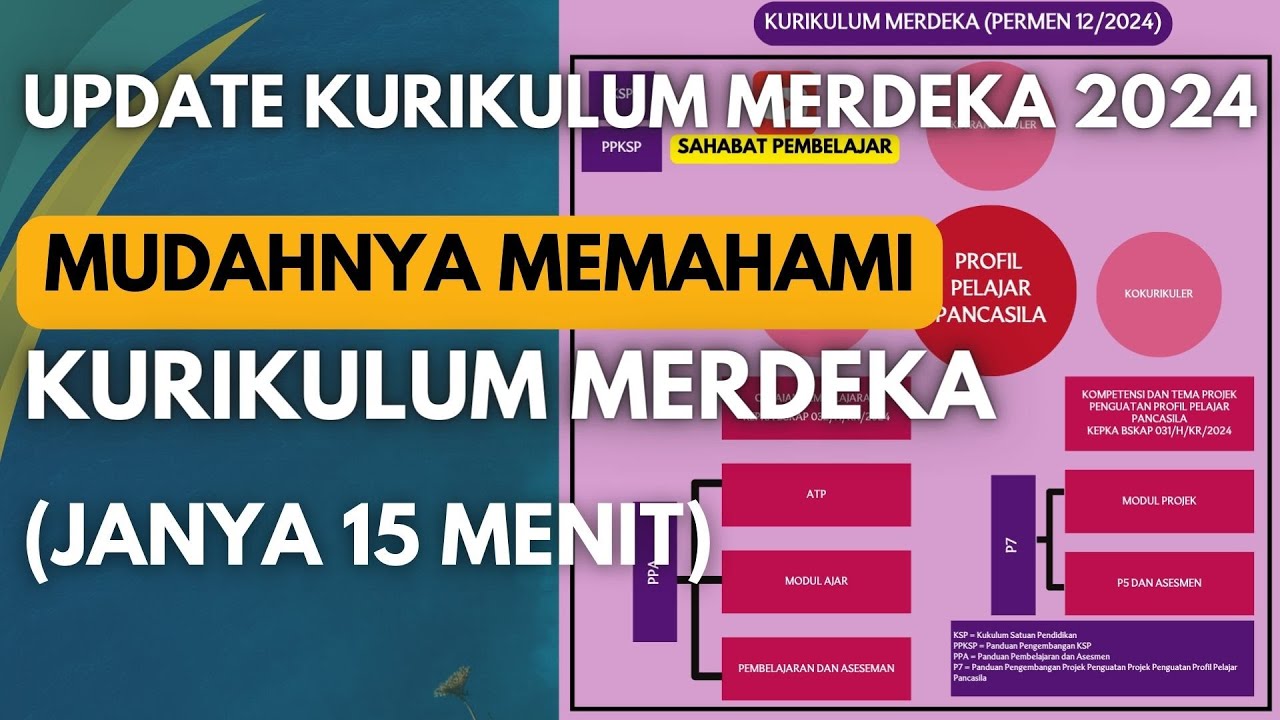HANYA 15 MENIT ANDA AKAN PAHAM PRINSIP KURIKULUM MERDEKA || SERI KURIKULUM MERDEKA #11
Summary
TLDRThis video explains the essence of the Merdeka Curriculum in Indonesia, designed to simplify its understanding for educators. The core of the curriculum emphasizes the Pancasila Student Profile, focusing on six dimensions such as faith, global diversity, teamwork, creativity, independence, and critical thinking. The video details how the curriculum is divided into four key activities: school culture, extracurricular, intramural, and Pancasila Profile strengthening projects. The speaker also highlights the importance of thematic projects and provides guidelines on how teachers can prepare learning tools like lesson plans and project modules.
Takeaways
- 📚 The video discusses the difficulties many people face in understanding the Merdeka curriculum, aiming to clarify its basic framework.
- 📝 The core principle of the Merdeka curriculum is the Pancasila Student Profile, which was not present in previous curricula like character education programs.
- 💡 The Pancasila Student Profile includes six dimensions: faith in God and noble character, global diversity, teamwork, creativity, independence, and critical thinking.
- 🍞 To simplify remembering the dimensions, the speaker uses the acronym 'makan roti manis', linking it to the Pancasila Student Profile.
- 🏫 The Merdeka curriculum includes four main approaches: school culture, extracurricular activities, intramural activities, and the Pancasila Student Profile Strengthening Project (P5).
- 📊 Intramural activities focus on regular lessons (70-80% of time) based on learning outcomes, while P5 projects (20-30%) are theme-based and not tied to specific learning outcomes.
- 📘 The government provides seven themes for non-vocational schools and eight for vocational schools to guide P5 projects.
- 📄 Teachers are required to prepare teaching materials, including ATP (Learning Objectives Pathway) and teaching modules, which are simplified versions of lesson plans (RPP).
- 🛠️ P5 projects are designed around specific themes and follow a structured planning process, similar to the development of teaching modules.
- 🔑 Key documents for understanding and implementing the Merdeka curriculum include the Pancasila Student Profile, learning outcome documents, teaching and assessment guidelines, and P5 project guidelines.
Q & A
What is the main topic of the video script?
-The main topic of the video script is an explanation of the Merdeka Curriculum in Indonesia and how to understand it easily.
Why did the speaker create this content?
-The speaker created the content because many people struggle to understand the Merdeka Curriculum, based on observations from training sessions and discussions on Facebook.
What is the key principle in the Merdeka Curriculum?
-The key principle in the Merdeka Curriculum is the 'Profil Pelajar Pancasila,' which focuses on character and competency development.
How does the 'Profil Pelajar Pancasila' differ from previous curricula?
-While similar to previous initiatives like 'Penguatan Pendidikan Karakter' and 'Budi Pekerti,' the 'Profil Pelajar Pancasila' is different because it emphasizes clear and visible actions in learning rather than being just a part of lesson plans.
What are the six dimensions of 'Profil Pelajar Pancasila'?
-The six dimensions are: being faithful to God and having noble character, global diversity, cooperation, creativity, independence, and critical thinking.
What acronym does the speaker use to simplify the six dimensions of 'Profil Pelajar Pancasila'?
-The speaker uses the acronym 'Makan Roti Manis,' which stands for the key concepts of the six dimensions.
How is learning structured in the Merdeka Curriculum?
-Learning in the Merdeka Curriculum is structured around four key approaches: school culture, extracurricular activities, intrakurikuler (regular classes), and project-based learning aimed at strengthening 'Profil Pelajar Pancasila.'
What is the difference between 'Intrakurikuler' and 'Project-based learning' in the Merdeka Curriculum?
-'Intrakurikuler' is regular learning based on 'Capaian Pembelajaran' (learning outcomes) and makes up 70-80% of the curriculum, while 'Project-based learning' focuses on themes provided by the government and comprises 20-30% of the curriculum.
What are some of the themes for 'Project-based learning' in the Merdeka Curriculum?
-Themes include entrepreneurship, local wisdom, sustainable living, democracy, character building, and technology innovation, among others.
What documents are essential for teachers to implement the Merdeka Curriculum?
-Teachers need four essential documents: the 'Profil Pelajar Pancasila' document, 'Capaian Pembelajaran,' the guide for teaching and assessment, and the project guide for strengthening 'Profil Pelajar Pancasila.'
Outlines

Cette section est réservée aux utilisateurs payants. Améliorez votre compte pour accéder à cette section.
Améliorer maintenantMindmap

Cette section est réservée aux utilisateurs payants. Améliorez votre compte pour accéder à cette section.
Améliorer maintenantKeywords

Cette section est réservée aux utilisateurs payants. Améliorez votre compte pour accéder à cette section.
Améliorer maintenantHighlights

Cette section est réservée aux utilisateurs payants. Améliorez votre compte pour accéder à cette section.
Améliorer maintenantTranscripts

Cette section est réservée aux utilisateurs payants. Améliorez votre compte pour accéder à cette section.
Améliorer maintenantVoir Plus de Vidéos Connexes

Implementasi Kurikulum Merdeka - Belajar Lebih Bermakna & Menyenangkan [Ni Made Meriandinata]

Proses Refleksi Pembelajaran

Materi Karya Fiksi ✅ Bahasa Indonesia Kelas 8 Kurikulum Merdeka

Guru Perlu Tahu ! Metode Penilaian pada Kurikulum Merdeka

Kurikulum dan Pembelajaran PAUD

MUDAHNYA MEMAHAMI KURIKULUM MERDEKA. CUKUP 15 MENIT. UPDATE KURIKULUM MERDEKA 2024
5.0 / 5 (0 votes)
